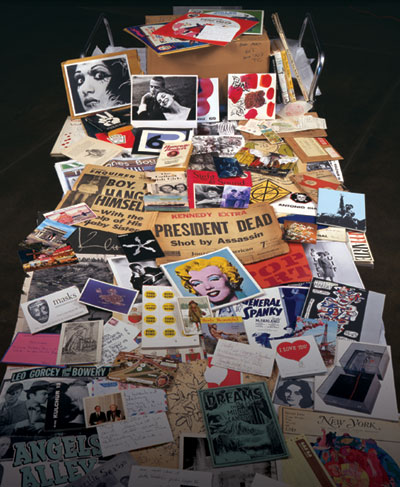Andy
Warhol Time Capsules
Lynne Margolis

Only a fraction of the more than 600 cardboard time
capsules that Andy Warhol filled with objects of his
daily existence have been opened, let alone unveiled
to the public in an exhibition of their own.
But the
Museum of Modern Art in Frankfurt, Germany, has been
collaborating with The Andy Warhol Museum
to create the first display of multiple entries in
Warhol’s curious, three-dimensional diaries.
The entire contents of 15 boxes will be shown this
fall at the Frankfurt museum in the exhibition Andy
Warhol Time Capsules.
The exhibition will be returned to The Warhol for
a similar display during fall 2004. While in Frankfurt,
the items will be intermingled with pieces from the
modern art museum’s permanent collection of works
by Warhol and other contemporary artists.
“
The scale of this show is immense,” says John
Smith, The Warhol’s assistant director for Collections
and Research. “Each box has 200 to 300 single
objects in it. Multiply that by 15 and you realize
how many different single pieces we’re dealing
with.
“
It would have been difficult for us to take on
a project like this on our own,” he continues.
To organize a tour of the exhibition required
this kind of really
close collaboration.”
Such collaborations
also give the museum opportunities to build exhibitions
it might not be able to afford
independently. “It’s one exhibition,
but both institutions will show it in completely
different
ways,” Smith says.
 The Warhol Director Thomas
Sokolowski points out that the institution’s
role as custodian of Warhol’s
legacy includes more than preservation and
study; it also means sharing his output with
other audiences
so that they might be able to understand and
appreciate
his work, and therefore, his life. The Warhol Director Thomas
Sokolowski points out that the institution’s
role as custodian of Warhol’s
legacy includes more than preservation and
study; it also means sharing his output with
other audiences
so that they might be able to understand and
appreciate
his work, and therefore, his life.
Because Warhol
apparently was the world’s biggest
packrat, curators had a tough time trying to
decide which of the 100 or so inventoried boxes
would go overseas.
“
We really tried to look for a selection of
boxes that seemed to represent the full range
of what the Time
Capsules are about,” Smith explains.
The goal, of course, was to show the most interesting
capsules, “without
losing sight of the fact that what makes these
things interesting is that a box might contain
a half-dozen
drawings from the 1950s, and in that same box
might be Warhol’s electric bill.”
Assistant
Archivist Matthew Wrbican says the chosen boxes
contain about four-dozen drawings.
One has
200 strips of photo booth snapshots. Another
features a
pair of Clark Gable’s shoes. They were
still on their shoe trees when Gable’s
widow mailed them to Warhol after catching
a gossip columnist’s
report—planted by Warhol—that he
was collecting celebrities’ shoes. Archivist
excavators found them in their original cardboard
mailing box, which
previously held cans of house paint.
It’s
hard for Wrbican to single out some of the
most exciting objects because, for him, a seemingly
innocuous receipt or unpaid bill might hold
clues that
lock pieces of Warhol’s puzzling life
together. Collectively, these items also uncover
many previously
hidden layers of his personality.
“
His humanity comes out in some of this material,” Smith
says.
He notes the boxes’ contents also
provide evidence that no one escapes the onslaught
of minutiae that
rules much of our daily lives.
“
Whether you’re an artist or an accountant,
you still get your electric bills and junk
mail,” Smith
notes with a laugh. Warhol’s boxes offer
insights as to just how much information we
encounter on a day-to-day
basis. And whether we like it or not, we have
to find ways of processing that information;
it just so happens
that Warhol’s method was far more eccentric
than most.
But who doesn’t fantasize about
tossing bills in a box and simply ignoring
them?
Warhol’s practice, Smith observes, “is
a way of dealing with it and not dealing with it at
the same time.”
Back to Contents
 The
Summer of Andy The
Summer of Andy
Continues Into Fall
The “Summer of Andy” days may be getting
shorter, but three important exhibitions remain on
display at The Andy Warhol Museum: Keith Edmier and
Farrah Fawcett; The American Supermarket; and Clown
Paintings: From the Collection of Diane Keaton and
Others.
Colleen Russell Criste, assistant director for
External Affairs, notes, “The Summer of Andy
concept has given us the chance to wrap our arms
around the museum’s
wide range of public events, including these special
exhibitions, the Good Fridays weekly happy hour and
performance series, our films, our wine tastings,
and more.”
The Edmier/Fawcett exhibition, continuing
through October 5, is the result of a two-year
partnership between
the original Charlie’s Angels icon and Edmier,
who invited her to become the subject of an artwork.
Instead, she became his collaborator, and together
they created drawings, photographs, and the exhibition’s
focus, life-sized nude sculptures of one another.
In the process, they scrutinized and deconstructed
both
the ties uniting and the barriers separating fans
and stars.
In 1964, Warhol and fellow Pop Art pioneers
Roy Lichtenstein, Richard Artschweiger, Robert
Watts,
and Tom Wesselman
combined their work in a groundbreaking exhibition
at the Bianchini Gallery in New York. The American
Supermarket, on display through October 5, is
a re-creation of that reality-blurring exhibition,
itself a re-creation
of a core element in the growth of consumerism.
Similar in nature to Warhol’s cookie jar collection,
Clown Paintings represents more than a simple
fascination with kitsch. These amateur paintings spoke
to their
collectors with an emotional intensity that’s
even more evident when viewed together. They
can be seen through October 26.
Back to Contents |